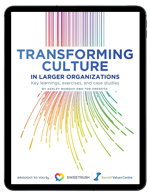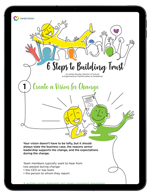As a leader of remote teams, you have important work in front of you—so does your team, who needs leadership and an organizational culture that supports them in being successful. Our panel of virtual leadership veterans and culture experts have answers for important questions, from fostering caring and trust to navigating a fear of failure.
At our recent webinar, Get the Inside Scoop on How to Lead High-Performing Teams When Working Remotely, we discussed challenges that leaders are facing due to COVID-19—leading remote teams for the first time, and leading through uncertainty.
SweetRush Cofounders Andrei Hedstrom and Arturo Schwartzberg brought insights based on 10 years of leading our 100% virtual company. Culture and change experts Gregg Kendrick, Ahmad El Nashar, and Quanita Roberson spoke about how to be present for your team and drive positive cultural change that benefits everyone in this moment. If you missed our session, you can still access the recording at eLearningIndustry.com!
Thank you for your great engagement and questions during the session. As promised, here are our reflections on the questions that we didn’t have time to answer during the session.
LEADING A TEAM
- How do you “stop by someone’s office” when you’re a remote manager? I typically did that by walking around. Now when I do it remotely, it seems artificial or forced.
- How do you manage team members who already have a sense of distrust with you as a lead/manager?
- How do you deal with someone on your team who has shown you that they cannot be trusted?
- We talk a lot about fear of failure. How have you been vulnerable and shown your teams it is OK to fail and thus build trust?
MANAGING UP
- How do you deal with difficult persons, especially from senior management, when trying to create mutual success? What is the best way to manage my manager?
- Can you please share ideas for emphasizing and building an atmosphere of caring and shared respect when it does not have top-down support?
LEADERSHIP PHILOSOPHY & CONCEPTS
- There are various types of leadership in society, such as autocratic, democratic, and laissez-faire. Psychology, inherent values, ethics, and moral values also affect leadership quality. Please help me understand what the qualities of a good leader are during coronavirus.
- I love systems thinking as long as the systems are open-ended and inclusive with real context. How do you contextualize any systems without excluding the value of other systems?
- Can you please explain how to “act with intentionality”?
- You use the words “sense of community” and culture. How do you differentiate them in building the levels of trust required when one is an input and the other may be an output?
LEADERSHIP INSPIRATION
- How has this inspired your clients in their own cultures? Any favorite stories to share?
- Where can I learn more about developing effective leadership skills and stronger, more productive teams?
LEADING A TEAM
How do you “stop by someone’s office” when you’re a remote manager? I typically did that by walking around. Now when I do it remotely, it seems artificial or forced.
 Ashley Munday: Real-time chat technologies can be a great way to “stop by someone’s office.” Skype and slack are both good examples of this. You can ping your employees and see if they have time for a brief chat. Create a routine of making the rounds and soon it will feel as natural as a casual drop-in. (Read more about Remote Team Communication and Technology.)
Ashley Munday: Real-time chat technologies can be a great way to “stop by someone’s office.” Skype and slack are both good examples of this. You can ping your employees and see if they have time for a brief chat. Create a routine of making the rounds and soon it will feel as natural as a casual drop-in. (Read more about Remote Team Communication and Technology.)
 Andrei Hedstrom: The heart of this work is about being curious and having empathy. Find a simple exercise to put your heart and mind on each person. I keep lists and I also try to keep a few minutes before a meeting or connection with a person to think about them and wonder about how they are doing and what they are working on. I keep another assertion fresh when I talk with them.
Andrei Hedstrom: The heart of this work is about being curious and having empathy. Find a simple exercise to put your heart and mind on each person. I keep lists and I also try to keep a few minutes before a meeting or connection with a person to think about them and wonder about how they are doing and what they are working on. I keep another assertion fresh when I talk with them.
Research has shown that people can be productive and feel good even in tough moments or settings when they believe they are making progress on something they believe is meaningful or has purpose. Part of my curiosity and service to people is keeping that front and center. I ask questions that help me get clear on whether they are focused on meaning and purpose and if they aren’t I focus my connections with them on that. Sometimes they don’t know what they are doing is meaningful, because they don’t have your context and need you to help them connect the dots to why it is important for the organization or for you or for peers.
When you ask these kinds of questions, you draw them closer to what matters to them, and they feel you focused on them and what is meaningful. Through this, you often discover a way that you can be of service to them, and if you take action, knocking down a barrier, giving them a resource, helping them think through a tricky conversation they need to have, they will see you differently.
The fact that you “walk around” is a good practice. In person, this shows you are available and care about them. Remotely, walking around looks different. I use some of the techniques mentioned above, but there are many ways to virtually walk around or gather that can feel genuine to you and your team. Experiment. If nothing seems to work, tell stories. Have a story that illustrates the values you want the team or the person to pick up. Have it be a story that you want to tell. Everyone loves stories.
How do you manage team members who already have a sense of distrust with you as a lead/manager?
 Ashley Munday: Leadership 360-degree assessments that collect anonymous feedback are a key way to understand how you are being perceived. At times, it could be a misperception, because the team members don’t understand your intention. Other times, it may be because they don’t believe that you advocate for their needs. This is important feedback to adjust your behaviors and communications.
Ashley Munday: Leadership 360-degree assessments that collect anonymous feedback are a key way to understand how you are being perceived. At times, it could be a misperception, because the team members don’t understand your intention. Other times, it may be because they don’t believe that you advocate for their needs. This is important feedback to adjust your behaviors and communications.
On another tack: Stephen M. Covey believes that trust is developed through competence, doing your job well, and character, how you act. Cultivate a culture of feedback and learning, both with one-on-ones with individual team members and together as a team. Frequently communicate about the culture you want to create and the strategic objectives you intend to achieve. It is not up to you to convince anyone to like you, but with clear communications and integrity of behavior, you will soon know who is truly aligned with where you are going.
 Gregg Kendrick: I agree wholeheartedly with Ashley’s comments. Additionally, I would encourage authentic conversations, both collectively with your team as a whole and individually. Encourage your team members to express their celebrations as well as their concerns. Listen and ensure they know you are listening—for example, write it down on a flip chart, reflect back what you are hearing, report back survey results, etc. For “whole team” conversations, you will likely find it advantageous to get an outside facilitator so you can focus on connecting with your team rather than holding the process of the conversation.
Gregg Kendrick: I agree wholeheartedly with Ashley’s comments. Additionally, I would encourage authentic conversations, both collectively with your team as a whole and individually. Encourage your team members to express their celebrations as well as their concerns. Listen and ensure they know you are listening—for example, write it down on a flip chart, reflect back what you are hearing, report back survey results, etc. For “whole team” conversations, you will likely find it advantageous to get an outside facilitator so you can focus on connecting with your team rather than holding the process of the conversation.
How do you deal with someone on your team who has shown you that they cannot be trusted?
 Ashley Munday: First, believe that they can change and be trustworthy again. Give that person clear feedback, about what did not work for you, and what you would hope for the future. Ask that person what’s going on in their life and work.
Ashley Munday: First, believe that they can change and be trustworthy again. Give that person clear feedback, about what did not work for you, and what you would hope for the future. Ask that person what’s going on in their life and work.
Going forward, make clear agreements. Encourage team members to negotiate the terms of what, how, and when it is delivered, so that they accomplish the work but do it in a way that makes sense to them as well. Empower team members to take ownership to renegotiate delivery terms if needed. We live in complex times and our priorities shift.
Lastly, if the person is repeatedly unable to meet agreements or to meet the needs of the role and team, it is fair to put that person on a Performance Improvement Plan to give them an opportunity to change their behaviors or to move on from that position.
We talk a lot about fear of failure. How have you been vulnerable and shown your teams it is OK to fail and thus build trust?
 Gregg Kendrick: At the core of a “fear of failure” is the mindset that when I make a mistake, when I get it wrong, I’ll be blamed, I’ll be punished, I’ll be seen as ‘less than.’ To build trust as a leader, the conversation needs to shift to owning the situation and learning from it. I often use coaching questions to support this difference—such as How did your choices and actions contribute to this situation? What would you do differently next time? What support would you need to make that happen? The key here is to shift from a “mistake/blame” mindset to a “ownership/learning” mindset.
Gregg Kendrick: At the core of a “fear of failure” is the mindset that when I make a mistake, when I get it wrong, I’ll be blamed, I’ll be punished, I’ll be seen as ‘less than.’ To build trust as a leader, the conversation needs to shift to owning the situation and learning from it. I often use coaching questions to support this difference—such as How did your choices and actions contribute to this situation? What would you do differently next time? What support would you need to make that happen? The key here is to shift from a “mistake/blame” mindset to a “ownership/learning” mindset.
Model this behavior by owning your own “mistakes” and being explicit about how you are learning from them. Even better, ask your team members to give you feedback when your own behaviors are not in alignment with core team values or principles. Share with your team members a specific behavior you are working on as a leader, and ask for their feedback around that behavior. Create an environment of mutual accountability.
 Andrei Hedstrom: Abolish the idea that people are basically bad or trying to get away with things, if you have any of that in you. People can smell that in a leader, even if you are trying to cover it over with the clichés of the day about failure. “There is no failure, only feedback” is something I keep fresh in my mind. You should also keep in mind that much of society has programmed us with the goal of being somehow perfect at what we do, even going so far as creating situations where people feel they should be perfect at something they are trying for the first time, or doing in unreasonable circumstances. They not only get into treating themselves this way, but end up with unrealistic expectations of perfection from others and expecting it of others. While privately we all know this is not realistic and can create situations for more suffering, blame, and defense, people’s general default setting is this way.
Andrei Hedstrom: Abolish the idea that people are basically bad or trying to get away with things, if you have any of that in you. People can smell that in a leader, even if you are trying to cover it over with the clichés of the day about failure. “There is no failure, only feedback” is something I keep fresh in my mind. You should also keep in mind that much of society has programmed us with the goal of being somehow perfect at what we do, even going so far as creating situations where people feel they should be perfect at something they are trying for the first time, or doing in unreasonable circumstances. They not only get into treating themselves this way, but end up with unrealistic expectations of perfection from others and expecting it of others. While privately we all know this is not realistic and can create situations for more suffering, blame, and defense, people’s general default setting is this way.
I lean on something I learned in my counseling graduate degree: Carl Rogers talked about “unconditional positive regard.” Extending through your actions and words a sense that you hold the person as basically good and even if their actions created challenges or a “failure,” you recognize it does not impact their basic goodness, and also the confidence they can work toward something better. So, all you give them in terms of direction or feedback will come from the assumption that you are both working from that basic good space and have abilities to improve. In that context, supporting and being vulnerable yourself is much simpler. I like to tell stories about my own moments of “failure” both with happy and not-so-happy endings. The moral of each story is typically pointing at coming to an understanding that being open to feedback inherent in challenging moments is a catalyst for growth, and feeling more satisfied about the outcomes of our work.
There are other angles you can work with this, and I would be happy to hear more specifics about your work and team and perhaps offer something more. I would add, and my guess is if you are holding this question, you might have already seen the research of Brene Brown. It’s compelling and feels easy to pick up (here’s her well-known TED Talk, “The Power of Vulnerability”).

Ashley Munday: I’m a big believer in cultivating the concepts of a Growth Mindset. I highly recommend having your team watch this TED talk and talk about learning and growth regularly in your team meetings. There are some innovative approaches to naming and learning from failure. One organization had a regular Church of Fail to celebrate the lessons learned. A client of mine had a #failfast competition and would reward the best failure and learning stories submitted each quarter.
MANAGING UP
How do you deal with difficult persons, especially from senior management, when trying to create mutual success? What is the best way to manage my manager?
 Arturo Schwartzberg: This is a challenge we have all faced. There is a fine art to posture yourself and act in a way that disarms another person, especially someone in senior management. Most people think of managing down, but rarely do people think of managing up, and it’s good to think about how to manage up.
Arturo Schwartzberg: This is a challenge we have all faced. There is a fine art to posture yourself and act in a way that disarms another person, especially someone in senior management. Most people think of managing down, but rarely do people think of managing up, and it’s good to think about how to manage up.
People are people, and they have egos and insecurities and each of us is different. How you might “manage up” to one individual who is difficult will take some thought and artful action on your part. Start by finding ways to let them know you care about them and empathize with some of the difficult challenges they are facing.
There are many techniques to get beyond someone’s surface shields or masks: Maybe you can ask them for their help and advice since people like to feel they are wise and their counsel is being sought. Maybe you can ask them to join you for a virtual coffee or lunch and open up a bit, make yourself a little vulnerable and see if you can get them on your side. These are just ideas, and each person is different; how you can get yourself and them into a mutually advantageous position is an art form you will need to cultivate and practice, and over time this will enable you to manage up and down elegantly.
Can you please share ideas for emphasizing and building an atmosphere of caring and shared respect when it does not have top-down support?
 Arturo Schwartzberg: When my daughter entered the workplace, she kept moving from one company to the next because the cultures were so bad, it was not going to hold onto this good-hearted millennial. Somehow I was surprised (naive) by just how bad these cultures were, in this day and age. Perhaps you find yourself in this sort of environment, and ultimately it may not hold you…but in the meantime, you are there and you have a team to support.
Arturo Schwartzberg: When my daughter entered the workplace, she kept moving from one company to the next because the cultures were so bad, it was not going to hold onto this good-hearted millennial. Somehow I was surprised (naive) by just how bad these cultures were, in this day and age. Perhaps you find yourself in this sort of environment, and ultimately it may not hold you…but in the meantime, you are there and you have a team to support.
So, do the right thing, show your team you care and, to some extent, you can align with them in a shared desire to be the team bucking the trend—without, of course, bad-rapping management (too much). This, of course, makes your job harder, but on a personal level, you can create magic, bond with your team, and, as a team, set goals for everyone to be awesome—not for the company, but for yourselves. Good luck!

Ashley Munday: Without top team support, it can be difficult to sustain a culture within a team that’s different from the overall organizational culture. That said, with a strong leader, an intact team can create their own norms and agreements about caring and shared respect with intention, practice, and dialogue to learn and grow together.
LEADERSHIP PHILOSOPHY & CONCEPTS
There are various types of leadership in society, such as autocratic, democratic, and laissez-faire. Psychology, inherent values, ethics, and moral values also affect leadership quality. Please help me understand what the qualities of a good leader are during coronavirus.

Andrei Hedstrom: Service and empathy. Care about your people to seek an understanding and a felt sense about what they are going through. Care about them, their family and community, and the work they care about. Once you have any insight about what they need, serve that need.
I sometimes think about leadership in terms of karma. Meaning, when you care about people, those good feelings are an investment in the relationship that you may benefit from later. Make good karma; take every advantage to create karmic credit with all the people you serve. It not only makes for better relationships when they have needs you need to serve, but also can be called upon as a favor when you need something from them. Everyone has needs and everyone wants love and respect. Every leadership style has to deal with that. Some look to suppress or control those. Servant leadership looks to attend those and balance the many needs around them while moving the organization’s needs forward.

Ashley Munday: Empathy first in this time. There’s a great piece that McKinsey recently put out titled “Cultivating Compassionate Leadership in a Crisis.”
I love systems thinking as long as the systems are open-ended and inclusive with real context. How do you contextualize any systems without excluding the value of other systems?
 Ahmad El Nashar: First, determine which level the system exists in: team/organization/society/global etc. Then, think about the internal and external components of each system, how they relate to each other, and how they are different. So, if you are in a team, some internal questions to ask as a team include What do our stakeholders expect from us? What is our purpose? What are our values/norms? How will we organize ourselves? Some external questions would include What external factors have an impact on our team? What information do we need from other teams? What information do we provide? How do we communicate with other teams? By answering such questions, you define the boundaries of your own system and its relationship with other systems.
Ahmad El Nashar: First, determine which level the system exists in: team/organization/society/global etc. Then, think about the internal and external components of each system, how they relate to each other, and how they are different. So, if you are in a team, some internal questions to ask as a team include What do our stakeholders expect from us? What is our purpose? What are our values/norms? How will we organize ourselves? Some external questions would include What external factors have an impact on our team? What information do we need from other teams? What information do we provide? How do we communicate with other teams? By answering such questions, you define the boundaries of your own system and its relationship with other systems.
Can you please explain how to “act with intentionality”?
 Ahmad El Nashar: Acting with intentionality is about being clear about the purpose of your actions. We are constantly receiving information that we should consider when taking actions to make sure we are taking into account this data we are receiving. Think about how many of us walk into meetings that are in our diaries—just because that has been the norm for years—when there are clear signs that the meeting is no longer serving its purpose. So, if you are in a meeting, what is the purpose of the meeting? What outcomes are you hoping to get out of it? Is the meeting designed to help the team achieve such an outcome?
Ahmad El Nashar: Acting with intentionality is about being clear about the purpose of your actions. We are constantly receiving information that we should consider when taking actions to make sure we are taking into account this data we are receiving. Think about how many of us walk into meetings that are in our diaries—just because that has been the norm for years—when there are clear signs that the meeting is no longer serving its purpose. So, if you are in a meeting, what is the purpose of the meeting? What outcomes are you hoping to get out of it? Is the meeting designed to help the team achieve such an outcome?
Similarly, acting with intentionality can manifest itself in many different ways. Another example is prioritization: How does a team prioritize tasks and goals? What influences their prioritization process? If you are creating a presentation, who is it serving and what is it trying to achieve? As an organization, how is our customer behavior changing? Are we still serving the right customer profile? Typically, we receive data that can help answer such questions, but a lot of time we don’t use it or tune into it, and fall victims of deeply entrenched habits. Acting with intentionality is essentially a mindset that helps us tune into the wider system and respond to it more effectively.
You use the words “sense of community”and culture. How do you differentiate them in building the levels of trust required when one is an input and the other may be an output?
 Gregg Kendrick: I see these two qualities as distinct, yet potentially highly related.
Gregg Kendrick: I see these two qualities as distinct, yet potentially highly related.
Belonging is a core human need. A person’s “sense of community” or “sense of belonging” in the workplace is nurtured when their contribution to the larger team or organization is seen and valued. For this to happen, the leader needs to first ensure the person has a clear role that’s defined in terms of the value it brings to the team and organization. Secondly, the person needs feedback from their peers and leaders that their contribution is seen. Not just the extraordinary ways they deliver value, but the tasks they do every day that are a part of their role. Belonging and being heard are two qualities that strengthen a person’s sense of self-worth (that is, that they matter).
In building a culture, leaders state what they value (that is, core values, purpose, principles) and more importantly demonstrate what they value both by their example and by creating a culture of accountability around what they value.
Another aspect of enhancing “sense of community,” then, is recognizing or “seeing” when a person is showing up in alignment with the organization’s core values, purpose, and principles, or having an accountability conversation when their behavior is not in alignment.
Of course, if one of the core values of the organization is “belonging” or “building a sense of community,” then you are amplifying this connection between culture and “sense of community.”
LEADERSHIP INSPIRATION
How has this inspired your clients in their own cultures? Any favorite stories to share?
 Arturo Schwartzberg: Thank you for asking this question as it has me thinking about how we—and really all of us—may have affected not only our clients, but people around us in ways we do not realize. We do have a clear philosophy about trying to make a positive contribution to every life we touch or that touches us.
Arturo Schwartzberg: Thank you for asking this question as it has me thinking about how we—and really all of us—may have affected not only our clients, but people around us in ways we do not realize. We do have a clear philosophy about trying to make a positive contribution to every life we touch or that touches us.
In our Talent Solutions group, we are often looking for talent for our internal team and often for our clients’ teams. Every time we have a job opening, we may get 100 or 500 resumes from applicants, people who want this job, and yet at the end of the day we will only hire one—and so 99 or 499 will be rejected. So we ask, how can we respond to these 499 in a way that is respectful and kind and somehow adds to their lives?
And so we try, and we try as well to act in a way with clients where they experience SweetRush being different. They experience a committed team that is respectful, but also intentional about acting in ways that are all about mutual success and not the success of one party over the other. Clients seem to love us and stick with us, so somehow I have to hope that our way of being rubs off.
Where can I learn more about developing effective leadership skills and stronger, more productive teams?
 If you’re in need of skill and competency building, Thrive by SweetRush has two established workshops that we just converted to virtual. These workshops upskill and benefit leaders and teams—both of which include creating customized action plans for moving forward,
If you’re in need of skill and competency building, Thrive by SweetRush has two established workshops that we just converted to virtual. These workshops upskill and benefit leaders and teams—both of which include creating customized action plans for moving forward,
Team Building: Creating Psychological Safety
Develop high-performing and collaborative teams that have a commitment to vision, strategy, and desired culture! Psychological safety is found to be the number one differentiator in Google’s highest-performing teams, and we want to help you achieve it.
Your Brain on Change: Decriminalize Resistance and Accelerate Adoption
The greatest leading indicator of a successful change effort is employees’ speed to adoption of new behaviors. This unique, neuroscience-based workshop develops the mindset and skills that improve speed to adoption.
Leading Remote Teams Consulting Package
We are offering real-time consulting and coaching to build cohesion and performance on your team in the remote environment. These sessions are facilitated by world-class consultants and coaches. We determine what your team most needs in terms of development. This is high-quality consulting, facilitation, and coaching on what matters to you in this moment to help your teams build momentum, performance, and morale. This package consists of 20 hours of coaching and consulting.
If you need a specialist to lead your meeting so you can participate in it, we also offer:
Online Meeting Facilitation
Need a skilled facilitator for an online meeting? We have excellent resources available and would be happy to discuss qualifications with you.
Contact Gregg at [email protected] or connect on LinkedIn.
EXPLORE THESE ADDITIONAL RESOURCES
 Transforming Culture in Larger Organizations: Key Learnings, Exercises, and Case Studies
Transforming Culture in Larger Organizations: Key Learnings, Exercises, and Case Studies
 Secrets of Effective L&D Leaders: Innovation, Embracing Change, and Cultural Transformation
Secrets of Effective L&D Leaders: Innovation, Embracing Change, and Cultural Transformation

 Infographic: 6 Steps to Building Trust
Infographic: 6 Steps to Building Trust Leading Remote Teams: Free Learning Resources
Leading Remote Teams: Free Learning Resources


